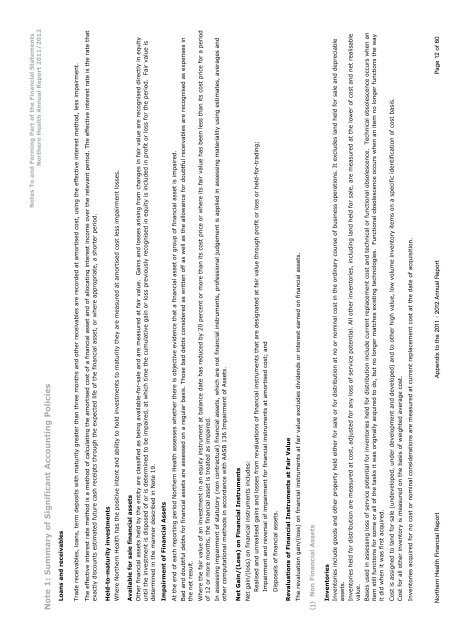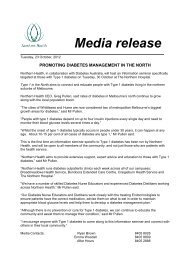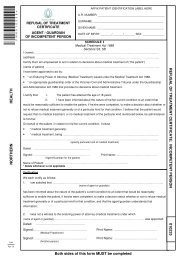Annual Report - Northern Health
Annual Report - Northern Health
Annual Report - Northern Health
You also want an ePaper? Increase the reach of your titles
YUMPU automatically turns print PDFs into web optimized ePapers that Google loves.
Note 1: Summary of Significant Accounting PoliciesNotes To and Forming Part of the Financial Statements<strong>Northern</strong> <strong>Health</strong> <strong>Annual</strong> <strong>Report</strong> 2011/2012Loans and receivablesTrade receivables, loans, term deposits with maturity greater than three months and other receivables are recorded at amortised cost, using the effective interest method, less impairment.The effective interest rate method is a method of calculating the amortised cost of a financial asset and of allocating interest income over the relevant period. The effective interest rate is the rate thatexactly discounts estimated future cash receipts through the expected life of the financial asset, or where appropriate, a shorter period.Held-to-maturity investmentsWhere <strong>Northern</strong> <strong>Health</strong> has the positive intent and ability to hold investments to maturity they are measured at amortised cost less impairment losses.Available for sale financial assetsOther financial assets held by the entity are classified as being available-for-sale and are measured at fair value. Gains and losses arising from changes in fair value are recognised directly in equityuntil the investment is disposed of or is determined to be impaired, at which time the cumulative gain or loss previously recognised in equity is included in profit or loss for the period. Fair value isdetermined in the manner described in Note 19.Impairment of Financial AssetsAt the end of each reporting period <strong>Northern</strong> <strong>Health</strong> assesses whether there is objective evidence that a financial asset or group of financial asset is impaired.Bad and doubtful debts for financial assets are assessed on a regular basis. Those bad debts considered as written off as well as the allowance for doubtful receivables are recognised as expenses inthe net result.Where the fair value of an investment in an equity instrument at balance date has reduced by 20 percent or more than its cost price or where its fair value has been less than its cost price for a periodof 12 or more months, the financial asset is treated as impaired.In assessing impairment of statutory (non contractual) financial assets, which are not financial instruments, professional judgement is applied in assessing materiality using estimates, averages andother computational methods in accordance with AASB 136 Impairment of Assets.Net Gain/(Loss) on Financial InstrumentsNet gain/(loss) on financial instruments includes:Realised and unrealised gains and losses from revaluations of financial instruments that are designated at fair value through profit or loss or held-for-trading;Impairment and reversal of impairment for financial instruments at amortised cost; andDisposals of financial assets.Revaluations of Financial Instruments at Fair ValueThe revaluation gain/(loss) on financial instruments at fair value excludes dividends or interest earned on financial assets.(j) Non Financial AssetsInventoriesInventories include goods and other property held either for sale or for distribution at no or nominal cost in the ordinary course of business operations. It excludes land held for sale and depreciableassets.Inventories held for distribution are measured at cost, adjusted for any loss of service potential. All other inventories, including land held for sale, are measured at the lower of cost and net realisablevalue.Bases used in assessing loss of service potential for inventories held for distribution include current replacement cost and technical or functional obsolescence. Technical obsolescence occurs when anitem still functions for some or all of the tasks it was originally acquired to do, but no longer matches existing technologies. Functional obsolescence occurs when an item no longer functions the wayit did when it was first acquired.Cost is assigned to land for sale (undeveloped, under development and developed) and to other high value, low volume inventory items on a specific identification of cost basis.Cost for all other inventory is measured on the basis of weighted average cost.Inventories acquired for no cost or nominal considerations are measured at current replacement cost at the date of acquisition.<strong>Northern</strong> <strong>Health</strong> Financial <strong>Report</strong> Appendix to the 2011 - 2012 <strong>Annual</strong> <strong>Report</strong> Page 12 of 60
















